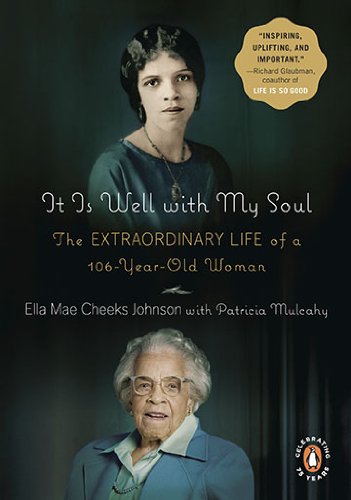02 Apr / It Is Well with My Soul: The Extraordinary Life of a 106-Year-Old Woman by Ella Mae Johnson with Patricia Mulcahy [in Christian Science Monitor]

 “Some of the things in this book happened a hundred years ago…. I never anticipated having to remember all this,” says Ella Mae Cheeks Johnson as she opens her memoir, It Is Well with My Soul: The Extraordinary Life of a 106-Year-Old Woman, written with Patricia Mulcahy. Über-centenarian Johnson recalled more than most people half her age. Sadly, her readers can’t expect a sequel to her delightfully plain-spoken memoir as she passed away on March 22. (The memoir’s original publication date in May was quickly pushed up, making the book available now.)
“Some of the things in this book happened a hundred years ago…. I never anticipated having to remember all this,” says Ella Mae Cheeks Johnson as she opens her memoir, It Is Well with My Soul: The Extraordinary Life of a 106-Year-Old Woman, written with Patricia Mulcahy. Über-centenarian Johnson recalled more than most people half her age. Sadly, her readers can’t expect a sequel to her delightfully plain-spoken memoir as she passed away on March 22. (The memoir’s original publication date in May was quickly pushed up, making the book available now.)
Born Jan. 13, 1904, in Dallas at a time when “black citizens had no official papers,” Johnson was raised by her next-door neighbors, the Davis family, after the death of her mother. “Everything in the Davis environment left me certain I was loved,” she writes.
Yet despite a nurturing home environment, in many ways Johnson’s early years were harsh ones. Growing up poor but never needy, she couldn’t escape the helpless humiliation faced by “blacks, or Negroes, or colored people, or whatever they called us.” She watched as “some things were out of Papa’s control,” how adults “had to lie in order to survive,” and the “many ways in which we were put in our place in the Jim Crow South.”
Johnson graduated salutatorian to her valedictorian best friend from Dallas Colored High School and, in 1921, entered Fisk University, a historically African- American college in Tennessee. During an art class in her senior year, Johnson painted a copy of a picture based on the biblical story of the “The Good Samaritan”: “My entire life has been driven by my emotional and spiritual response to the picture, and the message of compassion it communicates,” she writes.
Johnson finished Fisk six months later than anticipated because she missed a semester participating in a college-wide boycott orchestrated by legendary Fisk graduate W.E.B. Du Bois who “agitate[d] for the rights of his people, whatever they wanted to call us – Negro, colored, black.” Lest you think Johnson a lemming, even in a clear battle for civil rights, she feistily adds, “I don’t follow just because someone else decides to lead.”
After working briefly for the Congregational Church in Raleigh, North Carolina, Johnson arrived in Ohio – where she would live the rest of her life – as one of only two minority students admitted each year at Western Reserve University’s School of Applied Social Science. Decades later, the school was renamed Case Western Reserve University, and Johnson was recognized (until her recent death) as the oldest living African-American graduate of CWRU. … [click here for more]
Review: Christian Science Monitor, April 2, 2010
Readers: Young Adult, Adult
Published: 2010
